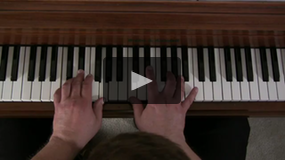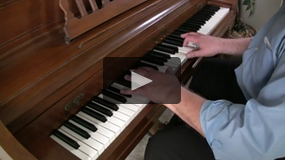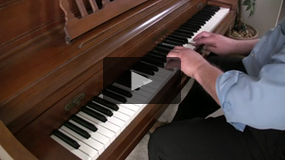Let’s Enjoy Piano is a book about learning popular, jazz and new age piano.
Get to the point, play for enjoyment.
An innovative, different, diversified and efficient approach that employs the
“Essential Knowledge” method for developing self-expressive skills:
improvising, composing, accompanying and jamming.
Testimonials
“User friendly, written in an efficient,
step by step manner.” — Jazz Education Journal
“Nicely illustrated ... written like the author’s right here talking to me!” —Student
“Gives me straight-forward information I can apply to any song I want to learn to play!” —Student
“Lets the student develop a personal style.” —American Music Teacher
What separates Let’s Enjoy Piano from other methods:
Exactly what you need to know
On each page, at a glance, I’ll show you a picture of exactly what you need to know to accelerate your progress on a specific topic.
Think, visualize and feel
Develop an ability to read the keyboard and visualize and feel chord patterns using a hand positioning technique I call, “Melody Centering.” Memorize all styles of music as you play, because you can recognize and understand what your hands are doing.
Suitable for all levels of musical experience
Whatever your level of playing and piano goals are, Let’s Enjoy Piano will resolve your frustrations and quickly turn your goals into reality.
Now, let’s enjoy piano! — Gary Rosato
Most books promise you everything, then swamp you
with excess information that you’ll never use.
Let’s Enjoy Piano allows you to work immediately with any chosen song, and teaches you to
apply only necessary strategies for rapid progress. Take a look at the excerpts below.
From the Introduction, Getting Oriented:
Take the mystery out of all those notes!
“As we isolate a measure of the full piano staff, we find roughly 8–16 notes within; however, all these notes (melody and harmony) are actually members of only 1–2 chord patterns indicated by the chord symbols above (illustration). These patterns have a certain shape on the music staff and a corresponding shape on the keyboard.”
“By learning to recognize specific patterns on the music, you will be able to translate them quickly into their corresponding hand positions on the keyboard.”
From p.38, Step by Step Approach to Lead Sheet Playing:
Sound professional with a full piano sound!
“To ensure smooth playing, smooth transitions from one melody centering position to the next are essential. This requires visual pre-planning, i.e., before leaving one position, visualize your next position. Once you move, lean into it so that all keys will come down at the same time. This will produce a solid and confident transition which will bridge the musical thoughts to form one coherent musical phrase.”
“Exercise: From your current song, sketch out, on the keyboards below (illustrations), those transitions that are giving you difficulty. This will help you focus on exactly what movements are needed.”
From p.53, Reading the Keyboard:
Learn the song through the, “eyes of the composer” ... when a song is created, the composer works from visualized patterns on the keyboard and creates the song long before the sheet music page actually exists.
“Learning a song with a visual understanding of what’s going on on the keyboard – melody centering position – will most certainly enhance your self-confidence during performance and ... you are learning the song as the composer created it, and it sticks!”
You actually memorize as you play.
“Remember, approximately 70% of RH melody notes will match the LH Chord Tones (i.e., melody chord tones). This gives us a blending or relaxation effect. The other 30% are Non Chord Tones, and this gives us a certain degree of tension. This balance between tension and relaxation is what keeps the music interesting and the audience interested! Being aware of which melody notes are CT or NCT will allow you to bring out some and subdue others, and therefore, produce a more controlled and balanced interpretation.”
Table of Contents
Fundamentals
- Keyboard/Staff
- Fingering/Pedaling
- Note and Rest Values/Meter/Dotted Notes
- Reading Music: Intervals
- Triad Chords (Shapes on Keyboard)
- Seventh Chords
- Chord Notation
- Chord Tone / Non Chord Tone Chart
- Chromatic LH Thumb / Chromatic RH Pinky Excercise
- Chord Fill In / “Eyeballing” Chord Patterns
- Chord Shapes on Staff / LH Fingering / Common Tones
- Cycle of 5ths (Major and Minor Progressions)
- Applying Rhythm and Meter to Cycle of 5ths
- Glossary
Practice Suggestions
- Time Management
- How to Practice
- Approaching Each Practice Session
- Evaluate
Lead Sheet Improvisation
Select your music & let’s play!- The Lead Sheet
- “Two Pinky Method”
- Rhythm of Harmony
- Re-naming Chord Symbols / Slash Chords
- Step by Step Approach to Lead Sheet Playing
- Style of the LH/Progressions
- LH Improvisation Patterns (Meter and Direction)
- Examples of LH Rhythm Patterns
- “Finger Drumming” Coordination Method
- Melody Centering
- Integration of RH Syncopation Over Steady LH
Interpretation
- Interpretation of a Musical Script
- Musical Communication Cycle
- Embellishing Techniques
- Memorizing Techniques
- Performing Tips
Plurality
- Orientation/“Chord FLow” (Accompaniment – Rhythm Patterns)
- 9 Chords
- Complete Harmony
- Incomplete Harmony
- Altered Chords
- Applying RH Plurality to a Lead Sheet
- Applying LH Plurality to a Lead Sheet
12 Bar Blues
- Basic Layout
- Rhythmic Alteration of Motive via “ADRES”
- Swingin’ – (Applying #1, #2)
- Motive Selection
- “Blues Scale Blues” (Applying the Blues Scale)
Composing
- Composing Music
- Scoring Layout
- Form Layout
- Composition Checklist
- Composition Techniques “TOADIIICCREEESS”
- Score Sketch – (Applying #1 – #5)
Original Piano Solos
- Waterfall Serenade, a.k.a. Flying Away
- Carnival Dance
- Bittersweet Moments, a.k.a. Lost in Winter
- Marathon, a.k.a. Thunderstorm
- Silk Dreams
- Happy Ending
G.R. Educational Publications
170 Farmers Lane, Jackson, NJ 08527 | email@letsenjoypiano.com
Content copyright © G.R. Educational Publications. All rights reserved.
YouTube Videos — view all
More products
-
“Harmony” Quick Reference Guide · $30
For the intermediate/advanced jazz/pop pianist (especially useful for classically-trained pianists).
-
Video Chat Piano Lessons · $50
60-minute online lessons. Email email@letsenjoypiano.com to schedule a time and day.


